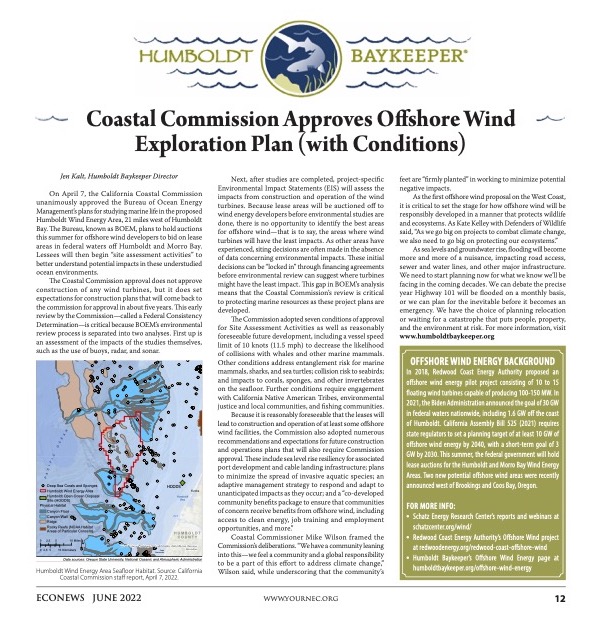 On April 7, the California Coastal Commission unanimously approved the Bureau of Ocean Energy Management’s plans for studying marine life in the proposed Humboldt Wind Energy Area, 21 miles west of Humboldt Bay. The Bureau, known as BOEM, plans to hold auctions this summer for offshore wind developers to bid on lease areas in federal waters off Humboldt and Morro Bay. Lessees will then begin “site assessment activities” to better understand potential impacts in these understudied ocean environments.
On April 7, the California Coastal Commission unanimously approved the Bureau of Ocean Energy Management’s plans for studying marine life in the proposed Humboldt Wind Energy Area, 21 miles west of Humboldt Bay. The Bureau, known as BOEM, plans to hold auctions this summer for offshore wind developers to bid on lease areas in federal waters off Humboldt and Morro Bay. Lessees will then begin “site assessment activities” to better understand potential impacts in these understudied ocean environments. This Coastal Commission decision does not approve construction of any wind turbines, but it does set expectations for construction plans that will come back to the commission for approval in about five years. This early review by the Commission—called a Federal Consistency Determination—is critical because BOEM’s environmental review process is separated into two analyses. First up is an assessment of the impacts of the studies themselves, such as the use of buoys, radar, and sonar.
Next, after studies are completed, project-specific Environmental Impact Statements (EIS) will assess the impacts from construction and operation of the wind turbines. Because lease areas will be auctioned off to wind energy developers before environmental studies are done, there is no opportunity to identify the best areas for offshore wind—that is to say, the areas where wind turbines will have the least impacts. As other areas have experienced, siting decisions are often made in the absence of data concerning environmental impacts. These initial decisions can be “locked in” through financing agreements before environmental review can suggest where turbines might have the least impact. This gap in BOEM’s analysis means that the Coastal Commission’s review is critical to protecting marine resources as these project plans are developed.
The Commission adopted seven conditions of approval for Site Assessment Activities as well as reasonably foreseeable future development, including a vessel speed limit of 10 knots (11.5 mph) to decrease the likelihood of collisions with whales and other marine mammals. Other conditions address entanglement risk for marine mammals, sharks, and sea turtles; collision risk to seabirds; and impacts to corals, sponges, and other invertebrates on the seafloor. Further conditions require engagement with California Native American Tribes, environmental justice and local communities, and fishing communities.
Because it is reasonably foreseeable that the leases will lead to construction and operation of at least some offshore wind facilities, the Commission also adopted numerous recommendations and expectations for future construction and operations plans that will also require Commission approval. These include sea level rise resiliency for associated port development and cable landing infrastructure; plans to minimize the spread of invasive aquatic species; an adaptive management strategy to respond and adapt to unanticipated impacts as they occur; and a “co-developed community benefits package to ensure that communities of concern receive benefits from offshore wind, including access to clean energy, job training and employment opportunities, and more.”
Coastal Commissioner Mike Wilson framed the Commission’s deliberations. “We have a community leaning into this—we feel a community and a global responsibility to be a part of this effort to address climate change,” Wilson said, while underscoring that the community’s feet are “firmly planted” in working to minimize potential negative impacts.
As the first offshore wind proposal on the West Coast, it is critical to set the stage for how offshore wind will be responsibly developed in a manner that protects wildlife and ecosystems. As Kate Kelley with Defenders of Wildlife said, “As we go big on projects to combat climate change, we also need to go big on protecting our ecosystems.”
As sea levels and groundwater rise, flooding will become more and more of a nuisance, impacting road access, sewer and water lines, and other major infrastructure. We need to start planning now for what we know we’ll be facing in the coming decades. We can debate the precise year Highway 101 will be flooded on a monthly basis, or we can plan for the inevitable before it becomes an emergency. We have the choice of planning relocation or waiting for a catastrophe that puts people, property, and the environment at risk.
For more info:
- Schatz Energy Research Center’s reports and webinars
- Redwood Coast Energy Authority’s Offshore Wind project


